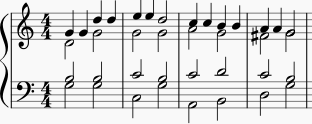 Today's Blogging A-to-Z challenge entry builds on yesterday's by adding a third voice to a simple two-voice example to create harmony.
Today's Blogging A-to-Z challenge entry builds on yesterday's by adding a third voice to a simple two-voice example to create harmony.
Simply put, harmony is any two notes sounded together. But in practice, harmony involves chords, which comprise groups of 3 or more notes sounded together.
Let's start with a recognizable melody:

Now I'll add a bass line, to give it a little more depth (and, for astute observers, outline the chord progression that we'll hear in step 3):

So there are implied harmonies in there, but let's flesh them out:

That harmony is simply I-I-IV-I, ii-(I6)-V7-I, which is about as simple as it gets.
But you can hear that once we have complete chords under the melody, it sounds a lot richer, and has more direction. And I'll address some of the techniques that make this particular progression work two weeks from Thursday.
Tomorrow: the post that should have gone second.
*The (I6) means even though the chord looks like a tonic chord, it's really behaving more like a passing chord. But hey, it's a simple harmonization of a children's melody.